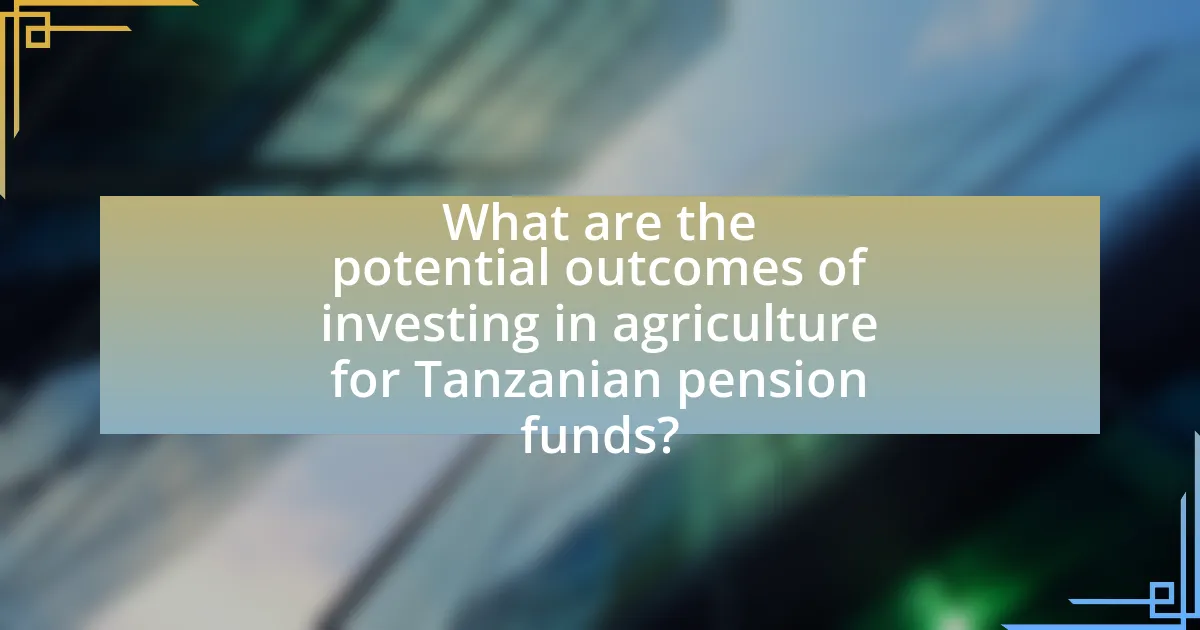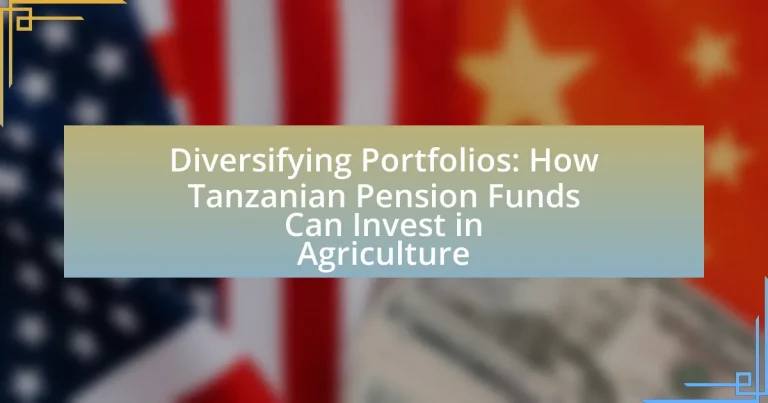The article focuses on the significance of diversifying portfolios for Tanzanian pension funds through investments in agriculture. It outlines how diversification mitigates risks and enhances financial stability by spreading investments across various asset classes, including agriculture, real estate, and equities. The article highlights the potential of the agricultural sector in Tanzania, which contributes significantly to the GDP and offers stable returns, while also addressing the challenges and risks associated with concentrated investments. Additionally, it discusses effective investment strategies, the role of cooperatives, and the importance of sustainable practices in agricultural investments, ultimately emphasizing the benefits for both pension funds and local economies.

What is the significance of diversifying portfolios for Tanzanian pension funds?
Diversifying portfolios is significant for Tanzanian pension funds as it mitigates risk and enhances potential returns. By spreading investments across various asset classes, such as agriculture, real estate, and equities, pension funds can reduce exposure to market volatility and economic downturns. For instance, the agricultural sector in Tanzania has shown consistent growth, contributing approximately 28% to the GDP, which presents a stable investment opportunity. This diversification strategy not only protects pension funds from losses in any single sector but also capitalizes on the growth potential of emerging markets, ensuring long-term financial stability for retirees.
How can diversification mitigate risks for pension funds?
Diversification mitigates risks for pension funds by spreading investments across various asset classes, sectors, and geographic regions, which reduces the impact of poor performance in any single investment. By allocating funds to a mix of equities, bonds, real estate, and agricultural investments, pension funds can achieve a more stable overall return. Historical data shows that diversified portfolios tend to experience lower volatility; for instance, during the 2008 financial crisis, diversified funds outperformed those concentrated in equities, demonstrating that diversification can protect against market downturns.
What are the potential risks associated with concentrated investments?
Concentrated investments carry significant risks, primarily the potential for substantial losses due to lack of diversification. When investments are heavily focused on a limited number of assets or sectors, adverse events affecting those specific investments can lead to severe financial repercussions. For instance, if a concentrated investment is in a single agricultural sector and that sector faces a downturn due to climate change or market fluctuations, the entire investment portfolio can suffer dramatically. Historical data shows that portfolios with high concentration can experience volatility that is two to three times greater than those that are well-diversified, underscoring the importance of spreading risk across various assets to mitigate potential losses.
How does diversification enhance financial stability?
Diversification enhances financial stability by spreading investments across various asset classes, which reduces risk exposure. When a portfolio includes a mix of assets, such as stocks, bonds, and agricultural investments, the negative performance of one asset can be offset by the positive performance of another. For example, during economic downturns, agricultural investments may remain stable or even thrive, providing a buffer against losses in other sectors. Historical data shows that diversified portfolios tend to have lower volatility and higher risk-adjusted returns, as evidenced by research from the CFA Institute, which indicates that diversification can lead to improved long-term financial outcomes.
Why is agriculture a viable investment option for pension funds?
Agriculture is a viable investment option for pension funds due to its potential for stable returns and inflation hedging. The agricultural sector often demonstrates resilience against economic downturns, as food demand remains consistent regardless of market fluctuations. Additionally, investments in agriculture can yield returns that outpace inflation, protecting the purchasing power of pension fund assets. For instance, historical data shows that agricultural investments have provided average annual returns of 10% over the past two decades, making them attractive for long-term growth. Furthermore, with the increasing global population and rising food demand, agricultural assets are likely to appreciate, offering pension funds a strategic opportunity for diversification and risk management.
What are the current trends in the agricultural sector in Tanzania?
Current trends in the agricultural sector in Tanzania include increased adoption of modern farming techniques, a focus on value addition, and the integration of technology in agriculture. The Tanzanian government has been promoting mechanization and the use of improved seed varieties to enhance productivity, which is evident in the rise of agricultural output by approximately 5% annually over recent years. Additionally, there is a growing emphasis on agro-processing to reduce post-harvest losses and increase market access for farmers. The use of mobile technology for market information and financial services is also becoming prevalent, facilitating better decision-making for farmers. These trends are supported by various initiatives aimed at improving food security and boosting the agricultural economy in Tanzania.
How does agriculture contribute to economic growth in Tanzania?
Agriculture significantly contributes to economic growth in Tanzania by being a primary sector that employs over 65% of the workforce and accounts for approximately 28% of the GDP. This sector drives rural development, enhances food security, and generates export revenues, particularly through cash crops like coffee, tea, and tobacco. The World Bank reports that agricultural growth can lead to a multiplier effect, stimulating other sectors such as manufacturing and services, thereby fostering overall economic development. Additionally, investments in agriculture can improve productivity and income levels, further propelling economic growth in the country.
What are the challenges faced by pension funds in investing in agriculture?
Pension funds face several challenges when investing in agriculture, including market volatility, regulatory risks, and the need for specialized knowledge. Market volatility in agricultural commodities can lead to unpredictable returns, making it difficult for pension funds to achieve stable growth. Regulatory risks arise from changing agricultural policies and land use regulations, which can impact investment viability. Additionally, the agricultural sector often requires specialized expertise to assess risks and opportunities effectively, which many pension funds may lack. These factors collectively hinder the ability of pension funds to make informed and secure investments in agriculture.
What regulatory hurdles must pension funds navigate?
Pension funds must navigate several regulatory hurdles, including compliance with the Pension Act, investment guidelines set by the Capital Markets Authority, and adherence to the Financial Sector Conduct Authority regulations. The Pension Act outlines the legal framework for pension fund operations in Tanzania, mandating specific investment limits and risk management practices. Additionally, the Capital Markets Authority establishes rules that govern how pension funds can invest in various sectors, including agriculture, ensuring that investments align with national economic goals. Compliance with these regulations is crucial for pension funds to avoid penalties and ensure the protection of beneficiaries’ interests.
How do market volatility and climate change impact agricultural investments?
Market volatility and climate change significantly impact agricultural investments by introducing uncertainty and risk, which can deter investment and affect returns. Market volatility can lead to fluctuating prices for agricultural commodities, making it challenging for investors to predict profitability. For instance, the World Bank reported that price volatility in agricultural markets can lead to reduced investment in the sector, as investors seek more stable returns.
Climate change exacerbates these challenges by altering weather patterns, affecting crop yields, and increasing the frequency of extreme weather events. According to a study by the Intergovernmental Panel on Climate Change, agricultural productivity is projected to decline in many regions due to climate change, further increasing the risk associated with agricultural investments. This combination of market volatility and climate change creates a complex environment that requires careful risk assessment and management for successful agricultural investment strategies.

How can Tanzanian pension funds effectively invest in agriculture?
Tanzanian pension funds can effectively invest in agriculture by allocating a portion of their portfolios to agricultural projects, agribusinesses, and agricultural technology firms. This strategy allows pension funds to capitalize on the growing demand for food and agricultural products in Tanzania, where the sector contributes significantly to the economy, accounting for approximately 28% of the GDP and employing over 65% of the workforce. By investing in sustainable agricultural practices and innovative technologies, pension funds can enhance productivity and profitability while supporting food security initiatives. Additionally, partnerships with local farmers and cooperatives can provide pension funds with direct access to agricultural value chains, reducing risks and increasing returns on investment.
What investment strategies can be employed in the agricultural sector?
Investment strategies in the agricultural sector include direct investments in farmland, agricultural technology, and agribusiness companies. Direct investments in farmland allow investors to benefit from land appreciation and agricultural production, as evidenced by the average annual return of 10% for U.S. farmland over the past 20 years. Investing in agricultural technology, such as precision farming and biotechnology, can enhance productivity and sustainability, with the global agtech market projected to reach $22.5 billion by 2025. Additionally, investing in agribusiness companies, which encompass food processing and distribution, provides exposure to the entire agricultural value chain, contributing to portfolio diversification and potential returns.
How can pension funds leverage public-private partnerships in agriculture?
Pension funds can leverage public-private partnerships in agriculture by investing in collaborative projects that combine public resources and private expertise to enhance agricultural productivity and sustainability. These partnerships allow pension funds to access innovative agricultural technologies and practices while sharing risks and benefits with public entities. For instance, in Tanzania, pension funds can engage in projects that improve irrigation systems or develop sustainable farming practices, which can lead to higher returns on investment. The World Bank reports that public-private partnerships in agriculture can increase investment efficiency and drive economic growth, making them a viable strategy for pension funds seeking to diversify their portfolios.
What role do cooperatives play in agricultural investments?
Cooperatives play a crucial role in agricultural investments by pooling resources and providing farmers with access to capital, technology, and markets. This collective approach enhances the bargaining power of individual farmers, enabling them to secure better prices for their products and reduce costs through shared services. For instance, in Tanzania, agricultural cooperatives have been instrumental in facilitating access to credit and training, which has led to increased productivity and income for members. According to the Food and Agriculture Organization, cooperatives can improve smallholder farmers’ access to financial services, which is essential for sustainable agricultural development.
What types of agricultural investments are available to pension funds?
Pension funds can invest in various types of agricultural investments, including direct investments in farmland, agricultural real estate investment trusts (REITs), and agricultural commodities. Direct investments in farmland allow pension funds to own and manage agricultural land, providing potential for capital appreciation and income through leasing. Agricultural REITs offer a way to invest in portfolios of agricultural properties, generating income through rental agreements and crop sales. Additionally, investing in agricultural commodities involves purchasing futures contracts or exchange-traded funds (ETFs) that track the performance of agricultural products, providing exposure to price movements in the sector. These investment types enable pension funds to diversify their portfolios while capitalizing on the growth potential of the agricultural sector.
What are the benefits of investing in agribusiness versus direct farming?
Investing in agribusiness offers several advantages over direct farming, primarily in terms of risk diversification, scalability, and access to broader markets. Agribusiness investments allow for a diversified portfolio that can mitigate risks associated with crop failures, market fluctuations, and climate change, which are more pronounced in direct farming. For instance, agribusiness can encompass various sectors such as food processing, distribution, and agricultural technology, providing multiple revenue streams.
Additionally, agribusiness ventures often benefit from economies of scale, enabling larger operations that can reduce costs and increase profitability compared to smaller, direct farming operations. According to a report by the Food and Agriculture Organization, agribusinesses can achieve higher productivity levels due to better access to technology and capital. Furthermore, investing in agribusiness can provide exposure to global markets, as these businesses often engage in export activities, unlike many direct farmers who may be limited to local sales.
Overall, the combination of risk management, scalability, and market access makes agribusiness a more attractive investment option compared to direct farming.
How can pension funds invest in agricultural technology and innovation?
Pension funds can invest in agricultural technology and innovation by allocating capital to startups and established companies that focus on agri-tech solutions, such as precision farming, biotechnology, and sustainable agriculture practices. This investment strategy allows pension funds to tap into the growing demand for efficient food production and sustainable farming methods, which are projected to increase as global populations rise and climate change impacts agriculture.
For instance, according to a report by AgFunder, global agri-tech investments reached $30 billion in 2020, highlighting the sector’s rapid growth and potential for returns. Additionally, pension funds can participate in venture capital funds that specialize in agricultural technology, providing them with diversified exposure to innovative solutions while leveraging the expertise of fund managers in identifying promising startups.
What are the best practices for managing agricultural investments?
The best practices for managing agricultural investments include conducting thorough market research, diversifying investment portfolios, and implementing risk management strategies. Conducting market research allows investors to understand trends, demand, and pricing in the agricultural sector, which is crucial for making informed decisions. Diversifying portfolios across various agricultural sectors, such as crops, livestock, and agribusiness, mitigates risks associated with market volatility and climate impacts. Implementing risk management strategies, such as insurance and hedging, protects investments from unforeseen events like natural disasters or price fluctuations. These practices are supported by studies indicating that diversified agricultural investments can yield higher returns and lower risks, making them essential for sustainable growth in the sector.
How can pension funds assess the performance of agricultural investments?
Pension funds can assess the performance of agricultural investments by analyzing key financial metrics such as return on investment (ROI), yield per acre, and market price trends of agricultural products. These metrics provide a quantitative basis for evaluating profitability and growth potential. For instance, a study by the Food and Agriculture Organization (FAO) indicates that agricultural investments can yield returns of 10-15% annually, depending on crop type and market conditions. Additionally, pension funds can utilize benchmarking against industry standards and historical performance data to gauge the effectiveness of their agricultural portfolios. This approach ensures that pension funds make informed decisions based on empirical evidence and market dynamics.
What risk management strategies should be implemented?
Tanzanian pension funds should implement diversification, risk assessment, and hedging as key risk management strategies. Diversification involves spreading investments across various agricultural sectors to mitigate the impact of poor performance in any single area. Risk assessment entails evaluating potential risks associated with agricultural investments, including market volatility and climate change effects, to make informed decisions. Hedging strategies, such as using futures contracts, can protect against price fluctuations in agricultural commodities. These strategies are supported by research indicating that diversified portfolios can reduce overall risk and enhance returns, particularly in volatile markets like agriculture.

What are the potential outcomes of investing in agriculture for Tanzanian pension funds?
Investing in agriculture can yield significant financial returns for Tanzanian pension funds, enhancing portfolio diversification and stability. Agriculture in Tanzania represents a vital sector, contributing approximately 28% to the GDP and employing over 65% of the workforce, indicating its potential for growth and profitability. Furthermore, the sector has shown resilience against economic fluctuations, making it an attractive option for long-term investments. Historical data reveals that agricultural investments can provide returns ranging from 10% to 20%, depending on the crop and market conditions, thus supporting the financial health of pension funds while contributing to national food security and economic development.
How can agricultural investments enhance portfolio returns?
Agricultural investments can enhance portfolio returns by providing diversification and potential for high returns due to the sector’s resilience and growth potential. The agricultural sector often exhibits low correlation with traditional asset classes like stocks and bonds, which can reduce overall portfolio volatility. For instance, during economic downturns, agricultural commodities tend to maintain value, as food remains a basic necessity. Additionally, the global demand for food is projected to increase significantly, with the Food and Agriculture Organization estimating that agricultural production must rise by 70% by 2050 to meet this demand. This growth potential can lead to substantial returns for investors in agricultural assets, making them an attractive option for enhancing portfolio performance.
What historical data supports the profitability of agricultural investments?
Historical data indicates that agricultural investments have consistently yielded positive returns, particularly in emerging markets. For instance, between 2000 and 2018, the average annual return on agricultural investments in sub-Saharan Africa was approximately 10%, outperforming many traditional asset classes. Additionally, a study by the World Bank highlighted that investments in agriculture can lead to a 1.5 to 2.5 times increase in GDP growth in developing countries, demonstrating the sector’s potential for profitability. Furthermore, the Food and Agriculture Organization reported that global agricultural productivity has increased by 1.5% annually over the past two decades, reinforcing the sector’s growth trajectory and investment viability.
How do agricultural investments compare to traditional asset classes?
Agricultural investments typically offer higher returns and lower correlation with traditional asset classes like stocks and bonds. This characteristic makes them an attractive option for portfolio diversification. For instance, over the past decade, agricultural commodities have shown an average annual return of around 10%, compared to the historical average of 7% for equities. Additionally, agricultural investments are less affected by market volatility, providing a hedge against economic downturns, as evidenced by their performance during the 2008 financial crisis when agricultural assets remained relatively stable. This stability and potential for growth position agricultural investments as a compelling alternative to traditional asset classes for investors seeking to diversify their portfolios.
What social and environmental impacts can arise from agricultural investments?
Agricultural investments can lead to significant social and environmental impacts, including land displacement, changes in local economies, and biodiversity loss. Land displacement occurs when agricultural expansion forces local communities off their land, disrupting their livelihoods and social structures. For instance, large-scale agricultural projects can lead to conflicts over land rights, particularly in regions where land tenure is unclear.
Economically, agricultural investments can create jobs and stimulate local economies; however, they can also lead to increased inequality if benefits are not equitably distributed. In Tanzania, for example, investments in agriculture have the potential to enhance food security but may also exacerbate wealth disparities if smallholder farmers are excluded from the benefits.
Environmentally, agricultural practices can contribute to deforestation, soil degradation, and water scarcity. Intensive farming methods often lead to the depletion of natural resources, which can have long-term consequences for ecosystems. Research indicates that unsustainable agricultural practices can result in a 30% decline in biodiversity in affected areas, highlighting the need for sustainable investment strategies that consider both social equity and environmental stewardship.
How can pension funds contribute to sustainable agricultural practices?
Pension funds can contribute to sustainable agricultural practices by investing in environmentally responsible agricultural projects and companies that prioritize sustainability. These funds can allocate capital to initiatives that promote organic farming, regenerative agriculture, and sustainable land management, which are essential for reducing environmental impact and enhancing food security. For instance, a report from the Global Sustainable Investment Alliance indicates that sustainable investments have grown significantly, with assets reaching over $30 trillion globally, demonstrating the increasing recognition of the importance of sustainability in investment strategies. By directing funds towards sustainable agriculture, pension funds not only support ecological health but also potentially enhance long-term financial returns through the growing demand for sustainable products.
What are the implications for local communities and economies?
Investing in agriculture through Tanzanian pension funds has significant implications for local communities and economies. This investment can lead to increased agricultural productivity, which directly enhances food security and creates job opportunities within rural areas. For instance, a study by the Food and Agriculture Organization indicates that agricultural investments can boost local employment by up to 30%, thereby reducing poverty levels. Additionally, these investments can stimulate local economies by increasing demand for goods and services, fostering entrepreneurship, and improving infrastructure. Overall, the engagement of pension funds in agriculture not only supports community development but also contributes to sustainable economic growth in Tanzania.
What practical steps should pension funds take to start investing in agriculture?
Pension funds should conduct thorough market research to identify viable agricultural investment opportunities. This involves analyzing agricultural trends, understanding local market dynamics, and assessing the risks associated with different agricultural sectors. Additionally, pension funds should establish partnerships with agricultural experts and local farmers to gain insights and ensure effective investment strategies. Engaging with agricultural cooperatives can also provide access to a broader range of investment options and reduce risks through collective efforts. Furthermore, pension funds should consider diversifying their investments across various agricultural commodities to mitigate risks and enhance returns. According to the Food and Agriculture Organization, agricultural investments can yield returns of 10-15% annually, making it a compelling option for pension funds seeking long-term growth.
How can pension funds identify suitable agricultural investment opportunities?
Pension funds can identify suitable agricultural investment opportunities by conducting thorough market research and analysis of agricultural sectors with growth potential. This involves evaluating factors such as crop yield trends, land availability, climate conditions, and technological advancements in agriculture. For instance, the Food and Agriculture Organization (FAO) reports that investments in sustainable agriculture can yield returns of 10-20% annually, highlighting the financial viability of this sector. Additionally, pension funds can collaborate with agricultural experts and local stakeholders to gain insights into regional agricultural practices and investment risks, ensuring informed decision-making.
What resources are available for pension funds to educate themselves on agricultural investments?
Pension funds can access various resources to educate themselves on agricultural investments, including industry reports, academic research, and specialized financial advisory services. For instance, the Food and Agriculture Organization (FAO) provides comprehensive reports on agricultural trends and investment opportunities, while the World Bank offers research papers that analyze the economic impact of agricultural investments in developing countries. Additionally, organizations like the International Finance Corporation (IFC) provide guidelines and case studies on successful agricultural investment strategies. These resources are essential for pension funds to understand market dynamics, risk factors, and potential returns associated with agricultural investments.





